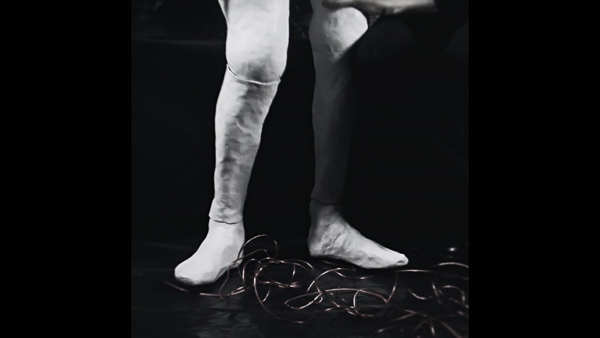„Czyż w lalce, która żyła tylko dzięki wkładanym w nią wyobrażeniom i która mimo bezgranicznej uległości potrafiła zachować dystans doprowadzający do rozpaczy; czy w kreowaniu takiej właśnie lalkowatości wyobraźnia nie mogła znaleźć tego, czego szukała w sferze rozkoszy i intensyfikacji? Czy nie oznaczało to ostatecznego triumfu nad tymi wielkookimi dziewczynkami o uciekającym w bok spojrzeniu, kiedy świadomy obserwator rozbójniczo brał w posiadanie ich wdzięk, kiedy palce, agresywne i chciwe wszystkiego, co da się uformować, człon po członie, powoli kształtowały to, co wydestylowały sobie zmysły i mózg?
Dopasować do siebie stawy, wypróbować maksymalny promień obrotu kul dla potrzeb dziecięcej pozy, zsuwać się powoli w zagłębienie, rozkoszować się wypukłościami, błądzić w muszli ucha, robić rzeczy piękne i nieco mściwie rozdzielać także sól deformacji. (...)
Czy to nie byłoby rozwiązanie?”
Hans Bellmer, Lalka
Hans Bellmer, The Doll
Bellmer's dolls
______________________________________________________________________________________________________________________
Sue Taylor, Hans Bellmer in The Art Institute of Chicago: The Wandering Libido and the Hysterical Body
______________________________________________________________________________________________________________________And didn’t the doll, which lived solely through the thoughts projected into it, and which despite its unlimited pliancy could be maddeningly stand-offish, didn’t the very creation of its dollishness contain the desire and intensity sought in it by the imagination? Didn’t it amount to the final triumph over those young girls – with their wide eyes and averted looks – when a conscious gaze plundered its charms, when aggressive fingers searching for something malleable allowed the distillates of mind and senses slowly to take form, limb by limb?
Fit one joint to the other, swivel the ball-joints full circle and test them for childlike poses, gently trace the hollows, savour the pleasures of the curves, stray into the opening of an ear, do pretty things while simultaneously scattering the salt of deformation with a hint of vengeance. (...)
Isn’t that the solution?
Hans Bellmer, The Doll
____________________________________________________________________________________________________
Szkice fotograficzne do "Rekonstrukcji lalki" / Photo sketches for the "Doll's reconstruction"
Sesja fotograficzna z ukończoną lalką / Photo session with the finished doll
Kadry z filmu / Video stills
______________________________________________________________________________________________________________________Bellmer's dolls
1. Standing about fifty-six inches tall, the doll consisted of a molded torso made of flax fiber, glue, and plaster; a masklike head of the same material with glass eyes and a long, unkept wig; and a pair of legs made form broomsticks or dowel rods. One of these limbs terminated in a wooden, clublike foot; the other was encased in a more naturalistic plaster shell, jointed at the knee and ankle. As the project progresses, Bellmer made a second set of hollow plaster legs, with wooden ball joints for the doll’s hips and knees. There were no arms to the wooden sculpture, but Bellmer did fashion or find a sigle wooden hand, which appears among the assortment of doll parts the artist documented in an untitled photograph of 1934, as well as in several photographs of a later work.
2. An important influence on this doll’s development was the artist’s discovery (...) of two sixteenth century articulated dolls in the collection of the Kaiser Friedrich Museum. The dolls, like the sort available at art supply stores to aid the study of the human figure, could be manipulated into various poses by means of moveable ball joints at the waist, hips, knees, ankles, shoulders, elbows, wrists, even the knuckles of the fingers and toes. These artifacts provided the model for a figure more mobile and versatile than Bellmer’s first doll, and he proceeded to fashion a “kit” of wooden and painted papier-mache body parts that could be intercharged and assembled into a female mannequin.
Recycling the head and the hand from the first doll, Bellmer produced arms, four legs, four round stylized breats, three pelvises, an upper torso, and a spherical belly. Accessories for this doll included a large hair bow, velvet (?) choker, two wigs (one blonde, one brunette) and a scrappy black toupée, long hose, white anklets, and two pairs of Mary Janes.
Sue Taylor, Hans Bellmer: The Anatomy of Anxiety
Sue Taylor, Hans Bellmer: The Anatomy of Anxiety
______________________________________________________________________________________________________________________
Overwhelmed with nostalgia and impossible longing, Bellmer acquired (...) a need, in his words, "to construct an artificial girl with anatomical possibilities...capable of re-creating the heights of passion even to inventing new desires."
Bellmer celebrated his invention of the doll in a delirious essay, "Memories of the Doll Theme" (1934): "It was worth all my obsessive efforts," he wrote, "when, amid the smell of glue and wet plaster, the essence of all that is impressive would take shape and become a real object to be possessed."Sue Taylor, Hans Bellmer in The Art Institute of Chicago: The Wandering Libido and the Hysterical Body
By using a process of addition and subtraction and by photographing his dolls in different positions and settings Bellmer provides a frame in which physical and sexual boundaries can be explored.
The doll is a perfect vehicle for Bellmer to explore his fantasies as she is infinitely malleable. In the sinister playground of Les Jeux de la Poupee he can investigate the extremes of his desire and continuously replay the kindling of it.
In Pay-Sage Bellmer seems to be trying to appropriate or redirect female jouissance towards himself but when faced with it he is overwhelmed. With the use of the ball-joint he discovers new sites for it which in Les Jeux de la Poupee he enviously tries to destroy or maim. In her restriction te life force is squeezed into her crevices as she defiantly refuses to die. This is an End game that has no victors, its perpetuation being crucial to desire. The doll is indestructible and desire is never satisfied. In answer to “What do you want?” Bellmer can only answer “More”.
Miranda Argyle, Hans Bellmer and The Games of the Doll

























